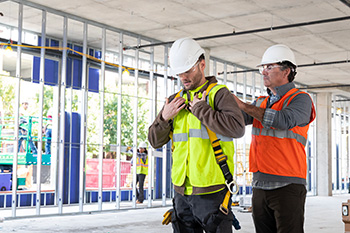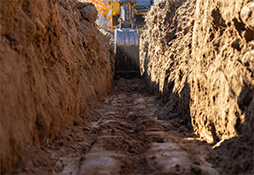Construction industry risk management resources
Featured articles

Addressing fall protection for the construction industry
Falls remain the leading cause of death in construction, an industry that remains one of the most dangerous in the United States

Rear end collision prevention
Rear-end collisions make up approximately 32% of all crashes, far exceeding other crash types. An organization needs to be proactive in preventing rear-end collisions. This article provides best practices to reduce your risk.
Trenching and excavation safety
Most all trenching and excavation injuries and fatalities are preventable. This article provides action steps contractors can take to keep workers safe.
Expand all
Administrative/Policies
- Emergency action plans
- Guidance for forming an effective safety committee
- Creating a safety culture
- 10 ways to help prevent accidents and injuries
- Basics of safety and health in construction
- Emergency action plans for construction
- Back to business: Returning workers in unusual times
- Incident report form | En Español
- Hearing conservation: Engineering controls
- Keep your employees safe + sound
- The workforce is changing
- Make every month a time to focus on safety
- No Harm No Foul flyer
- No Harm No Foul scorecard
- Job hazard analysis | En Español
- Job Hazard Analysis Form
- Emergency action plans for construction
- Young and inexperienced workers in non-agricultural jobs
- 4-Step Rx to Control Your Experience Mod
- Accident investigation as a loss control tool
- Construction jobsite activities log
- National Work Zone Awareness Week
Ergonomic
- Lifting safety
- Ergonomics screening tool
- Manual material handling
- Safety matters: Ergonomics for repetitive motions
- Ergonomic screening tool - Assembly task evaluation
- How to help prevent back injuries
- Five simple rules to reduce lifting injuries
- Ergonomics screening tool: Pushing & pulling tasks
- Ergonomic tips for your home workspace
Fall Protection Program
Fall Prevention
- Mobile elevated work platform safety: Quick tips
- Harness Inspection Checklist | En Español
- Proper Wearing of Safety Harnesses | En Español
- Avoid Costly Falls From Heights | En Español
- Nationwide stands down to prevent falls in construction
- Help prevent falls from heights
- Maintain three points of contact for climbing safety
- Supported scaffold safety
- Scaffolding: Check before use poster
- Mobile Equipment Work Platform (MEWP) safety
- Aerial lift checklist
- Portable ladder safety checklist
- Portable ladder safety
- Infographic poster — Ladder safety
- Ladder-alternative job sites | En Español
- Addressing fall protection for the construction industry
Machinery Safety
- Safety matters: Machine guarding
- Safety matters: Use the machine guard
- Lockout/tagout equipment assessment checklist
- Lockout/Tagout for protecting workers
- Equipment training and qualification interactive program
PPE
- Selecting Proper Eye Protection
- Personal protective equipment for keeping workers safe
- PPE hazard assessment checklist
Return to Work Program
- Successful Return-to-Work Program overview
- Using the 24/7 nurse triage hotline
- Choose the right provider to treat your injured employees
- Why is a Successful Return-to-Work Program so important?
- Create a Successful Return-to-Work Program
Chemical/IH
- Bloodborne pathogens in the workplace
- Hazard communication program for chemicals
- Safety matters: Chemical safety in the workplace
- Safety matters: Heat stress and heat-related illness
- Respirable crystalline silica in construction
- Preventing CO poisoning in your facility
- Recognizing the signs of frostbite
- Drug and alcohol use in the construction industry
- Manage heat-related risks to minimize work-related injuries
- Wildfire smoke: How to use AQI for worker safety
Confined Space
Trench Safety
- Trenching and excavation safety
- Trench safety posters
- Safety matters: Trench safety basics
- Safeguarding workers during trenching and excavation operations
Workplace Violence
- Workplace security checklist
- Workplace violence security assessment
- Workplace violence: Developing administrative controls
- Addressing the risk of active shooter incidents in the workplace
Toolbox Talks
Visit our toolbox talk webpage to access a wide range of jobsite safety topics
Accidents
- Accident investigation as a loss control tool
- Commercial auto accident reporting kit
- Post-accident reporting | En Español
- Accident register — DOT required
- Accident procedures for office staff
- Preventing rear-end, LOC & rollover accidents
- Drug and alcohol testing of drivers
Programs and Policies
- 2025 Fleet risk environment
- Driver road evaluations (road test)
- Drug and alcohol testing of drivers
- Fleet safety responsibility and safety committees
- Safe driving commitment form — Company vehicle operator | En Español
- Sample fleet safety/driver safety manual
- Sample fleet safety self-assessment
- Small fleets need attention, too!
Hiring
- Guidelines for hiring the right driver
- Motor vehicle records (MVR)
- Designating a driver trainer
- Driver qualification file best practices
- Driver qualification: Lowering requirements puts an organization at risk
- Driver road testing
- Drug and alcohol: CDL drivers
- Drug and alcohol clearinghouse
- Truck driver experience, violation and accident criteria
Non-owned Vehicles
Distracted Driving
DOT/CSA — General
- Do I need to comply with DOT requirements?
- Complying with DOT regulations (checklist)
- When do I need to comply with DOT and CDL requirements? (infographic)
- What drivers need to know about DOT compliance
- DOT safety audit resource guide
- DOT safety planner — general guidance and sample forms
- FMCSA portal
- Have you filed your biennial DOT update?
- Pre-employment screening program (PSP)
- SMS BASICS — Driver fitness
- SMS BASICS — HOS
- SMS BASICS — Maintenance
- SMS BASICS — Unsafe driving
- 2020 changes to FMCSA hours of service regulation
Driving Training
- Driver training – Online courses
- Driver training best practices
- Driver training resources page – 40+ topics
- New hire driver orientation
- Experienced driver training
- Driver safety meetings
- Monthly infographics for driver safety training
Maintenance
- DOT maintenance requirements
- Inspection and maintenance of non-regulated vehicles
- Owner operator maintenance
- Tire safety: Management
Trailer Safety
Telematics and Dashcams
- Why telematics?
- Telematics selection guide — Advanced
- Telematics: Build for construction
- Telematics implementation and coaching guide
- Telematics related smartphone apps: Improving driver safety
- Dashcams: Which is best for you?
- Dashcam benefits
- Dashcam selection guide
- Dashcam implementation guide
- Dashcam policies
Vehicle Management
Programs (Sign in to view content)
- CWMP interactive program
Program Components (Sign in to view content)
- Construction water mitigation roles and responsibilities
- CWMP self-audit
- Severe weather pre-planning checklist
- CWMP severe weather checklist: Wind, rain and hail
- CWMP severe weather checklist: Winter weather
- CWMP severe weather checklist: Hurricanes
- Wet work permit
- Wet work valve tags
- Water mitigation closing checklist
- Water damage response plan
Articles
- Temporary traffic control
- Construction job file sample checklist
- Foreman’s defect mitigation sample checklist
- Subcontractor prequalification and selection
- Drone use in the construction industry
- Cyber liability
- Protect your business against cyber attacks
- Contractors and New York labor law
- Exterior insulation and finish systems (EIFS)
- Strategies for protecting idle construction projects
- Contractor equipment theft
- Loss control for the construction industry
- Loss control services: Who we are and what we do
- 2021 construction industry outlook
- Virtual consultations in safety and risk management
- Preparing for post-pandemic growth with construction business owners
- New survey uncovers emerging construction risks and trends for business owners
- Helpful resources for construction Covid-19 risk mitigation
- Quality management self-assessment
- Reputation management – What have you got to lose?
- Crisis management
- Utility line safety
- Welding safety | En Español
- Arc flash safety
- Outdoor heater safety
- Fire extinguisher use and selection
- Inspect fire extinguishers to ensure proper operation
- Step-by-step fire extinguisher use
- Safely store idle pallets to minimize risk
- The right way to store idle pallets
- Store idle pallets properly to lower fire risk
- Flammable liquids
- Prevent dangers caused by flammable liquids
- Combustible hydraulic fluids
- How to help prevent an electrical room fire
- Preventing electrical fires
- 8 steps to prepare your business for wildfire
- Protecting commercial buildings from wildfire
- Take steps to reduce risk in wildfire-prone areas
- Automatic sprinkler plan review
- Hot work decision tree and permit for contractors
Wind/Hurricane
- Reducing tree damage from windstorms
- Preparing your business for stormy weather
- Make your business hurricane ready
- Hurricane-ready brochure
- How hail guards help protect roof-mounted HVAC equipment
- Protect your business during hurricane season
Flood
- Reducing the risk of flood damage
- 5 actions to reduce water damage
- What to do when flooding is imminent
Freezing
Browse more loss control articles
More industry resources
Subscribe to our newsletter for timely content in your inbox

